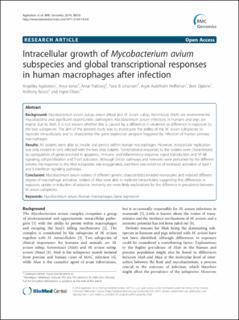| dc.contributor.author | Agdestein, Angelika | |
| dc.contributor.author | Jones, A | |
| dc.contributor.author | Flatberg, Arnar | |
| dc.contributor.author | Johansen, Tone Kristin Bjordal | |
| dc.contributor.author | Heffernan, Inger Austrheim | |
| dc.contributor.author | Djønne, Berit K | |
| dc.contributor.author | Bosco, A | |
| dc.contributor.author | Olsen, Ingrid | |
| dc.date.accessioned | 2020-06-02T14:43:32Z | |
| dc.date.available | 2020-06-02T14:43:32Z | |
| dc.date.created | 2014-10-16T14:20:44Z | |
| dc.date.issued | 2014 | |
| dc.identifier.issn | 1471-2164 | |
| dc.identifier.uri | https://hdl.handle.net/11250/2656241 | |
| dc.description.abstract | Background Mycobacterium avium subsp. avium (Maa) and M. avium subsp. hominissuis (Mah) are environmental mycobacteria and significant opportunistic pathogens. Mycobacterium avium infections in humans and pigs are mainly due to Mah. It is not known whether this is caused by a difference in virulence or difference in exposure to the two subspecies. The aim of the present study was to investigate the ability of the M. avium subspecies to replicate intracellularly and to characterise the gene expression program triggered by infection of human primary macrophages. Results All isolates were able to invade and persist within human macrophages. However, intracellular replication was only evident in cells infected with the two Maa isolates. Transcriptional responses to the isolates were characterized by upregulation of genes involved in apoptosis, immune- and inflammatory response, signal transduction and NF-kB signaling, cell proliferation and T-cell activation. Although similar pathways and networks were perturbed by the different isolates, the response to the Maa subspecies was exaggerated, and there was evidence of increased activation of type I and II interferon signaling pathways. Conclusion Mycobacterium avium isolates of different genetic characteristics invaded monocytes and induced different degree of macrophage activation. Isolates of Maa were able to replicate intracellularly suggesting that differences in exposure, uptake or induction of adaptive immunity are more likely explanations for the difference in prevalence between M. avium subspecies. | |
| dc.description.abstract | Intracellular growth of Mycobacterium avium subspecies and global transcriptional responses in human macrophages after infection | |
| dc.language.iso | eng | |
| dc.title | Intracellular growth of Mycobacterium avium subspecies and global transcriptional responses in human macrophages after infection | |
| dc.type | Peer reviewed | |
| dc.type | Journal article | |
| dc.description.version | publishedVersion | |
| cristin.ispublished | true | |
| cristin.fulltext | original | |
| cristin.qualitycode | 1 | |
| dc.identifier.doi | 10.1186/1471-2164-15-58 | |
| dc.identifier.cristin | 1164551 | |
| dc.source.journal | BMC Genomics | |
| dc.source.volume | 15 | |
| dc.source.issue | 58 | |
